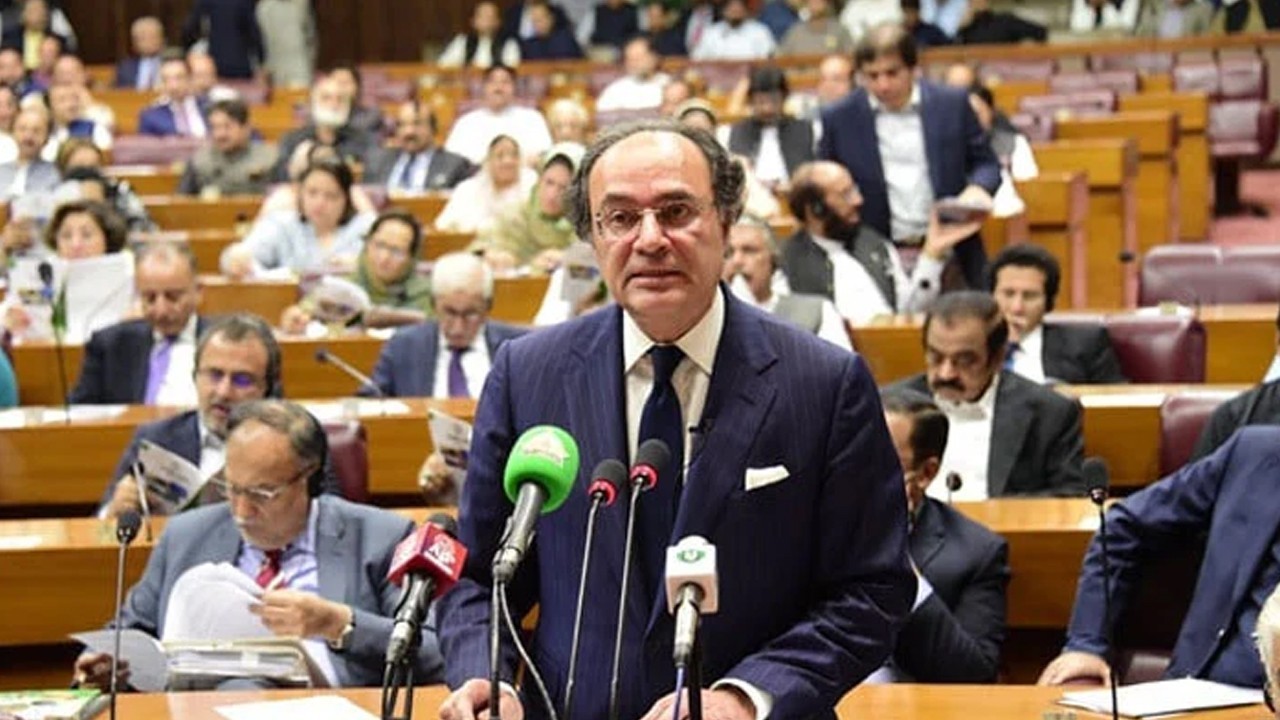Budget FY26: Aurangzeb says FBR overhaul crucial to meet Rs14.1tr tax target

Web Desk
|
10 Jun 2025
Finance Minister Muhammad Aurangzeb presented the federal budget for the upcoming fiscal year 2025-26 during a session of the National Assembly on Tuesday.
The budget, aimed at balancing economic growth, fiscal discipline, and tax measures, was unveiled amid loud protests from opposition lawmakers, who began chanting slogans as the session got underway.
Opening his budget speech in the session chaired by Speaker Sardar Ayaz Sadiq, Aurangzeb said, “This budget is being presented during a historic moment, as the country pressed on through difficult times.”
He added, “This budget is being presented at a historic time when the nation showed unity and determination,” referencing the recent tensions with India.
Emphasizing the importance of financial strength alongside national defense, he remarked, “The spirit with which we protected our national sovereignty, we need to ensure our financial security in the same way.”
Despite the disruption in the house, Aurangzeb continued his address, asserting, “Pakistan has now achieved economic stability and is moving towards a Pakistan that is prosperous.”
He pointed to signs of improvement, such as a current account surplus, strong remittance inflows, and a stable currency. He also noted encouraging assessments from global credit rating agencies, including Moody’s and Fitch, which recently revised Pakistan’s rating outlook upward.
The proposed federal budget for FY2026 has a total outlay of Rs17.573 trillion, reflecting a 6.9% reduction from last year’s allocation.
Aurangzeb emphasized the necessity of targeting a 14% tax-to-GDP ratio, describing it as unavoidable.
Ambitious tax collection target of Rs14.1 trillion
He stressed that meeting national fiscal goals would be “impossible without the transformation of the Federal Board of Revenue (FBR).” The government has set an ambitious tax collection target of Rs14,131 billion for the FBR — reflecting an 8.95% increase over last year’s target.
Outlining the reforms, the finance minister highlighted several technological initiatives, including B2B e-invoicing, AI-driven audit selection systems for both sales and income tax, electronic billing, faceless audits, and the establishment of a central control unit to streamline data consolidation.
Sharing the outcomes of these measures, he revealed that data integration led to the identification of 390,000 high-value individuals who had not filed taxes, resulting in a recovery of Rs300 million. He also noted a 100% surge in the number of tax filers, pushing total revenue collections to Rs105 billion.
“For the first time, the IMF has acknowledged Rs389bn revenues through law enforcement,” he stated.
Responding to criticism, he dismissed concerns about a mini-budget, saying the government had made no such move and mocking those who had sounded the alarm.
Tariff cut
On the energy front, the minister announced a 31% drop in electricity tariffs and a 50% cut in prices for protected consumers. Addressing the power sector’s restructuring, he remarked, “Professional boards have been cleared of political corruption.”
He also discussed government plans to secure low-cost energy by shutting down expensive power plants and initiating reforms in the oil and gas sectors. He added that Turkish and other foreign investors had shown interest in Pakistan’s energy market.
Citing the Reko Diq gold and copper project, the minister said it had received a $5 billion investment commitment. He noted that the feasibility study was completed in January and emphasized the project's transformative potential.
“Gold mines in Reko Diq are a key part of our future,” he said. “We expect $71bn in cash flows [as well as] $7bn in tax and $8bn in royalties,” calling the initiative a “game changer.”
Touching on the fiscal deficit, he said the government is targeting a reduction to 3.9% of GDP—amounting to Rs5,037 billion—compared to last fiscal year’s target of 5.9%.
Explaining the measures under the National Tariff Policy, Aurangzeb announced that additional customs duties would be phased out over four years, regulatory duties would be eliminated within five years, and Schedule 5 of the Customs Act would also be withdrawn in the same period.
He added that the new tariff structure would feature tiered slabs, with the highest rate capped at 15 per cent.
“These tariff reforms will be implemented gradually, allowing businesses time to adapt and easing potential disruptions. The changes will span across all key sectors, including pharmaceuticals, IT, telecom, textiles, and engineering,” he said.
Citing the World Bank, Aurangzeb stated that these policy instruments would help align Pakistan’s tariff levels with regional economies like Vietnam and Indonesia.
Shifting focus to debt management, he pointed out that the country had been burdened by debt repayments for two decades.
Debt-to-GDP ratio below 70 per cent
“Two years ago, the debt-to-GDP ratio stood at 74 per cent. Now, it’s below 70 per cent, and we aim to bring it down further,” he said. Efforts to diversify debt instruments include the issuance of Sukuk bonds and plans to introduce new financial products.
The finance minister also emphasized the ongoing reforms in loss-making state-owned enterprises to curb fiscal losses and attract investment. “We plan to finalize transactions related to PIA and the Roosevelt Hotel within this year,” he confirmed.
On pension reforms, he explained that future increases would be indexed to the Consumer Price Index (CPI).
Highlighting climate vulnerability, Aurangzeb underlined Pakistan’s need for international support and noted the availability of a $1.3 billion climate fund from the IMF.
In terms of social welfare, he reaffirmed the government’s commitment, noting that the Benazir Income Support Programme (BISP) had helped over 11 million children access education. Additionally, 1.5 million pregnant women and children had received financial aid, and 250,000 people were trained in financial literacy.
IT exports could grow to $25 billion in next five years
Touching on the digital sector, the minister shared that Pakistan’s global cybersecurity ranking had improved and that IT exports reached Rs3.1 billion in ten months—an increase of 21.2 per cent from the previous year. He projected that IT exports could grow to $25 billion in the next five years.
He told the parliament that the Small and Medium Enterprise Development Authority (SMEDA) had launched a three-year financial strategy for SMEs. Under a risk coverage scheme, Rs300 billion had been disbursed to 95,000 small and medium enterprises by May 2025.
Aurangzeb also spoke about a new housing scheme to make affordable homes accessible.
On remittances, he reported that overseas Pakistanis had sent $31.2 billion—an increase of 31 per cent, or $10 billion. Measures to support expatriates include an online portal, legal reforms to prevent fraud, reserved seats in chartered medical colleges, and civil awards for the top 15 contributors.
Regarding the agriculture sector, which makes up 34 per cent of the GDP, he said Rs2.64 billion was earned in FY2024–25. He added that the National Seed Policy 2025 and the National Agricultural Technology Policy 2025 were near finalization.
Looking ahead, Aurangzeb said the government was aiming to build a “competitive economy,” projecting 4.2 per cent GDP growth in the upcoming fiscal year. The fiscal deficit target has been set at 3.9 per cent of GDP, with a projected primary surplus of 2.4 per cent.
He noted that the government plans to collect Rs1.413 trillion in FBR revenues—an increase of 18.5 per cent compared to the previous year. The provinces’ share from federal revenues is expected to be Rs8.246 trillion.
He also lauded the role of the Strategic Investment and Facilitation Council (SIFC) in driving major greenfield and brownfield projects and improving coordination between federal and provincial entities.
Govt to expand water storage by 10 million acres
Referring once again to the recent tensions with India, the minister emphasized the urgency of enhancing water storage capacity. Under the National Water Policy of 2018, the government aims to expand water storage by 10 million acres, reduce water wastage by 35 per cent, and improve water-use efficiency by 30 per cent.
Aurangzeb said Rs133 billion had been earmarked for various projects, including Rs34 billion for investments and Rs2 billion for 15 priority schemes, with allocations for specific dam projects also detailed.
The finance minister emphasized the importance of ensuring affordable energy, announcing Rs90.2 billion for 47 energy-related initiatives. This includes allocations of Rs840 million for the Tarbela 5th Extension, Rs10.9 billion for the Dasu hydropower project, Rs3.5 billion for the Suki-Kinari plant, and Rs35.7 billion for the Mohmand dam.
Additional energy sector funding covers Rs4.4 billion for the Allama Iqbal Industrial City grid, Rs1.1 billion for the Quaid-i-Azam Business Park, Rs1.6 billion for transformer performance systems, Rs2.9 billion for IESCO’s smart metering infrastructure, Rs1.8 billion for MEPCO, Rs1.9 billion for Hyderabad, Rs2.4 billion for Peshawar upgrades, Rs67.2 billion for Wapda’s clean energy initiative, Rs3 billion for five projects in AJK and GB, and Rs1.2 billion for grid projects in Gilgit-Baltistan.
He also noted progress on the Matiari–Moro–Rahim Yar Khan transmission line.
Green Pakistan Initiative reviving the agriculture sector
Shifting focus to agriculture, he said the Green Pakistan Initiative was reviving the sector, with efforts directed at genetic upgrades and better post-harvest handling. He mentioned 1,000 agri graduates were sent to China on scholarships and unveiled five new livestock projects.
For education, the minister announced Rs39.5 billion for 170 Higher Education Commission projects, with Rs38.5 billion going to provincial initiatives. Under this programme, electric wheelchairs, laptops, and audiovisual equipment will be provided.
Regarding the IT sector, Rs4.8 billion was proposed for ongoing projects under the Uraan Pakistan plan, which includes TV modules, a PCB manufacturing facility, and a joint Pakistan-Korea testing lab.
He also said Rs9.8 billion would be allocated for establishing 11 new Danish schools—four in Balochistan, three in AJK, three in Gilgit-Baltistan, and one in Islamabad—to combat illiteracy.
He said that under the Public Sector Development Programme, Rs18.5 billion was reserved, with Rs3 billion dedicated to rebuilding schools in Sindh affected by floods. The PM’s Youth Skill Development Programme would receive Rs4.3 billion to train 165,100 young individuals, he added.
For healthcare, Rs14.3 billion was allocated across 21 PSDP projects, including Rs4 billion for the Jinnah Medical Complex in Islamabad, Rs1 billion for hepatitis eradication, Rs800 million for diabetes prevention, and Rs900 million for a new stroke center at PIMS.
Lastly, the minister outlined development funds for the regions: Rs164 billion in total, with Rs48 billion each for AJK and Gilgit-Baltistan, and Rs68 billion for the merged districts of Khyber Pakhtunkhwa.












Comments
0 comment